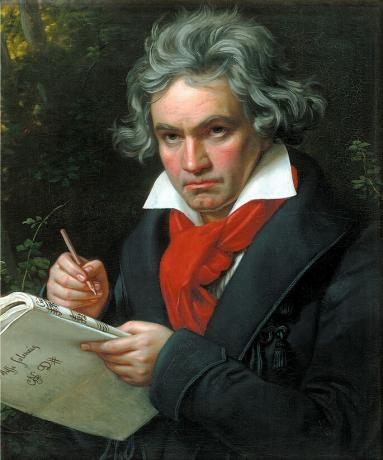Cândido Portinari is one of the national artists with the greatest worldwide recognition.
His paintings usually bring themes that portray the conditions in which the Brazilian people lived in the first half of the 20th century.
Portinari was very successful in highlighting social questions, popular festivals, work in the fields, childhood, among other subjects.
His unique and unmistakable style of painting was heavily inspired by the artistic avant-gardes that emerged in Europe in the transition from the 19th to the 20th century. However, the painter managed to absorb this influence and transform it into a genuinely Brazilian art.
We selected some important themes and works in the painter's trajectory and above all in the history of art in Brazil. Check out!
The worker on the Portinari site
Portinari was strongly dedicated to portraying the worker, mainly the one who toils using as an instrument his physical strength in the field.
Mixed race
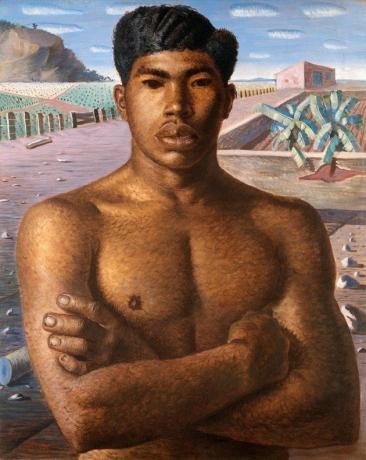
On this canvas, the painter displays a portrait of a strong man with his arms crossed, working on a coffee plantation.
The skin color and the subject's features - in addition to the title of the work - indicate that it is a mestizo person, the result of the mixture between the black, indigenous and white population.
Mixed race it was produced in 1934 using the oil on canvas technique, has dimensions of 81 x 65 cm and belongs to the collection of the Pinacoteca do Estado de São Paulo.
Coffee

Coffee is an important work by Portinari. It was painted in 1935 with oil paint, has a size of 130 x 195 cm and is located in the National Museum of Fine Arts, in Rio De Janeiro.
Here the painter portrayed a group of people during a hard day at work on a coffee farm. The workers' bodies are presented in a rigid and almost sculptural manner. People's hands and feet are big, highlighting the strength of manual labor.
In 1935, the canvas participated in the International Exhibition of Modern Art in New York, at the Carnegie Institute and received an honorable mention, the painter's first international prize.
The Coffee Farmer

One of Cândido Portinari's most emblematic works is the coffee farmer. Produced in 1934 with oil paint, the 100 x 81 cm canvas is part of the MASP collection.
In this work Portinari portrays the figure of a farmer leaning on his hoe. With bare feet, face in profile that contrasts with the light of the sky, and a T-shirt with sleeves rolled up, the man stands in a coffee plantation wearing an expression of tiredness and concern.
The strong and large feet once again symbolize the worker's vigor and suggest the artist's approach to the European expressionist movement.
Sugar cane
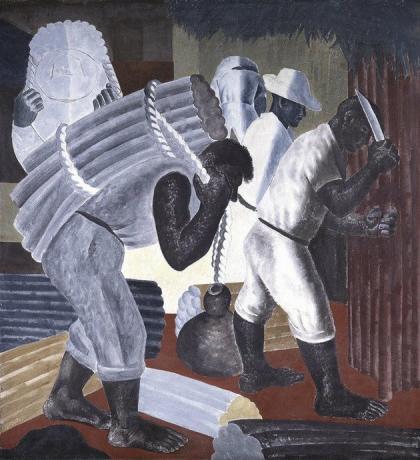
The technique used in performing Sugar cane was the fresco (mural painting method). The work was carried out in 1938 and has large dimensions, 280 cm x 247 cm.
It is located in the Palácio Capanema, a highlight of modern architecture, located in the city of Rio de Janeiro.
Here, Portinari also used the theme of the manual worker, this time in the production of sugarcane.
Northeastern migration in the work of Portinari
One of the themes addressed in Portinari's production was also the migration of part of the northeastern population to other parts of the country.
In search of better living conditions, entire families ventured on difficult and long journeys in order to escape poverty, hunger and infant mortality.
retreatants

This work shows a family of migrants who leave their place of origin in search of other opportunities in the big city.
With nine members, four adults and five children, the group is portrayed in a somber way, with skeletal and fragile bodies. The expressions on the faces are one of suffering and the chosen color palette highlights the sepulchral atmosphere that surrounds the characters.
The painting, painted in 1944, is a panel produced in oil on canvas, measuring 190 x 180 cm and part of the collection of the São Paulo Museum of Art (MASP).
dead child
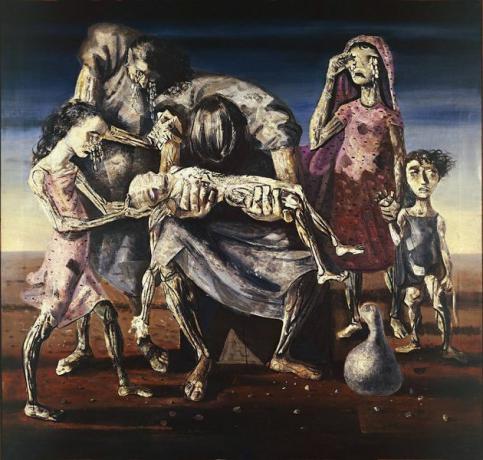
In the same year he paints retreatants - in 1944 - Portinari produces the canvas dead child. With 180 x 190 cm, the painting is also part of the collection of the São Paulo Museum of Art (MASP).
In the work, we see a person holding the scrawny and lifeless body of a child. Other figures moan and weep.
The weeping here is portrayed in thick tears that fall from the deep-set eyes of the characters, which highlights the suffering of the people of the Northeast who were constantly dealing with infant mortality in that time course.
Childhood in Portinari's work
The theme of childhood also fascinated Cândido Portinari. The painter exhibits in several works the children's universe, much lighter and more fluid.
Candinho, as he was called, was a boy of humble origins who grew up playing with other children in the town of Brodowski.
The memories of her childhood and her birthplace were always present in the artist's production. One of his speeches on the subject is:
The landscape where we played for the first time never leaves us.
Soccer
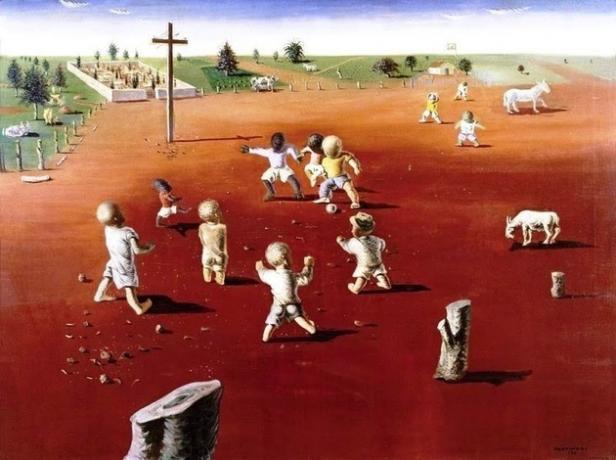
The board Soccer Dated 1935, it was done in oil on canvas in dimensions 97 x 130 cm and is part of a private collection.
The work depicts barefoot boys playing football on a dirt field. There are some animals and in the background we can see a small cemetery, a green field and a house.
The side light and the colors that the artist uses indicate that it is late afternoon.
Boys on the Balance
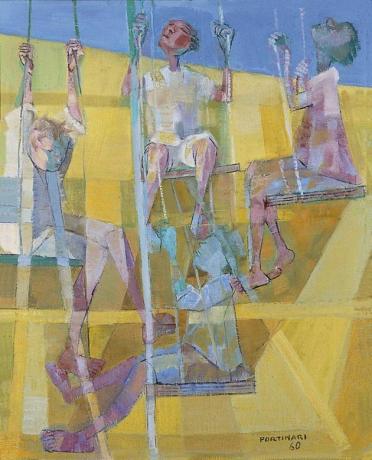
Portinari enjoyed painting children at play. This 1960 painting, made using the oil on canvas technique, measures 61 x 49 cm and is currently in a private collection.
In it, the artist portrays four boys having fun on swings. The tones are soft and bring variations of yellow, pink and blue.
The boys seem enveloped in an angelic aura and have their faces turned towards the sky, as if they feel the breeze of the day.
Cândido Portinari once said:
Do you know why I paint so many boys on seesaws and swings? To put them in the air like angels.
Who was Cândido Portinari?
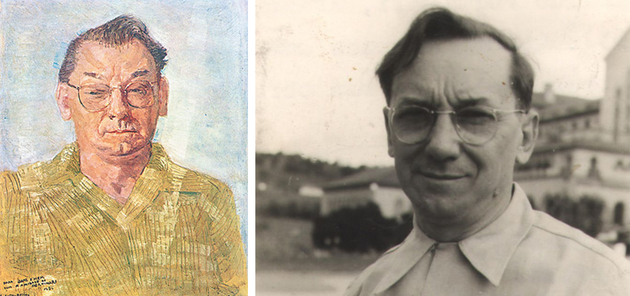
Cândido Portinari was born on a coffee farm in the city of Brodowski, interior of São Paulo, on December 30, 1903.
The artist had an intense trajectory and produced around 5,000 works, ranging from paintings, drawings and large murals.
An example of an important muralist panel is the work War and peace, which was offered in 1956 to the United Nations (UN), headquartered in New York and was recovered in 2010, and is currently at the Municipal Theater of Rio de Janeiro.
In the mid-1950s, the artist began to show serious health problems, being diagnosed with Saturnism, a disease caused by lead poisoning that certain paints had in their composition.
The artist was passionate about his craft and has great difficulty in obeying doctors' orders to abandon painting.
He died on February 6, 1962, at the age of 58. It leaves an invaluable legacy for Brazilian and world art, contributing enormously to the consolidation of the cultural identity of the Brazilian people.

